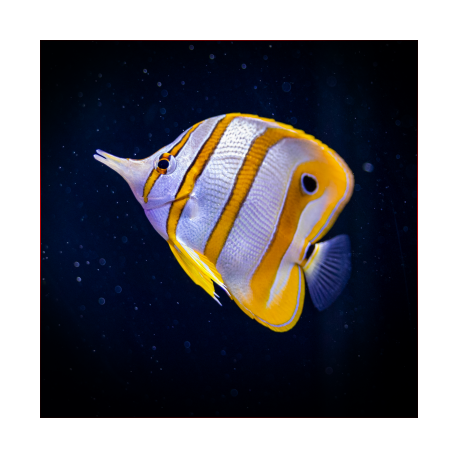More info
Datasheet
| Minimum Tank Size | 1000 litres / 264.17 US gallons |
| Maximum Size | 20.0cm / 7.87inches |
| Reef Compatible | Often reef safe |
| Temperament | Docile but might be aggressive towards similar species |
| Temperature | 22.2°C / 71.96°F - 25.6°C / 78.08°F |
| Specific Gravity | 1.020-1.025 |
| Carbonate Hardness | 8-12 |
| pH | 8.1-8.4 |
General Description
The Copperband Butterflyfish, known as Chelmon rostratus, belongs to the Chaetodontidae family. This species, native to the Western Pacific, specifically the Andaman Sea to the Ryukyu Islands and Australia, is characterized by its striking appearance and vibrant colors. It is commonly referred to as the Copperhand Butterflyfish, Beaked Butterflyfish, or Beaked Coralfish. These fish are adorned with attractive patterns that make them a sought-after choice for aquarium enthusiasts.
Aquarium Suitability
Being delicate in nature, the Copperband Butterflyfish is not easy to maintain in aquariums. Special care is required, as they can suddenly perish without apparent reasons. To increase the likelihood of their survival, a large tank with ample microorganisms is recommended. These fish are known to nibble at clams, including Tridacna species, and display a preference for tubeworms in their diet.
Demands, Care and Hardiness
Copperband Butterflyfish are shy and docile creatures, making them susceptible to aggressive tankmates. They are considered fastidious feeders, eating slowly and selectively. As a result, providing a varied diet and feeding several times a day, especially upon introduction to a new environment, is crucial for their well-being. These fish may initially refuse to eat in captivity, but given time, they typically adapt and consume live food more readily.
Reef Suitability
This species is often deemed reef-safe, making them suitable for reef aquariums with caution. However, some individuals may eat glass anemones (Aiptasia), while others may refuse to feed on them. It's important to monitor their behavior and diet closely in a reef setting to ensure their compatibility with other coral species.
Aquarium Setup
To accommodate a Copperband Butterflyfish, a well-established aquarium of at least 1000 liters is recommended. Maintaining stable water conditions with a pH range of 8.1-8.4, a temperature between 22.2-25.6°C, and a specific gravity of 1.020-1.025 is essential. Ensuring the presence of sufficient live food sources like copepods and amphipods is beneficial for their overall health.
Behaviour
Known for their peaceful demeanor, Copperband Butterflyfish generally coexist well with other non-aggressive tankmates. However, they may exhibit aggression towards similar species, emphasizing the importance of monitoring their interactions within the aquarium.
Feeding and Diet
Their diet consists of larger crustaceans, other invertebrates, small crustaceans like krill and mysis, as well as zooplankton. Offering a varied diet containing live foods is vital for their nutritional requirements and overall vitality.
Dimorphism
In terms of dimorphism, male and female Copperband Butterflyfish do not exhibit significant visual differences. While some species within the Chaetodontidae family can be bred in captivity, Copperband Butterflyfish are primarily known for their feeding habits and delicate nature.
Habitat and Distribution
Found in the West Indian Ocean, Australia, and Indonesia, the Copperband Butterflyfish inhabit coral reefs and lagoons where they can forage for food. Their distribution spans a wide area in the Western Pacific, highlighting their adaptability to diverse marine environments.

